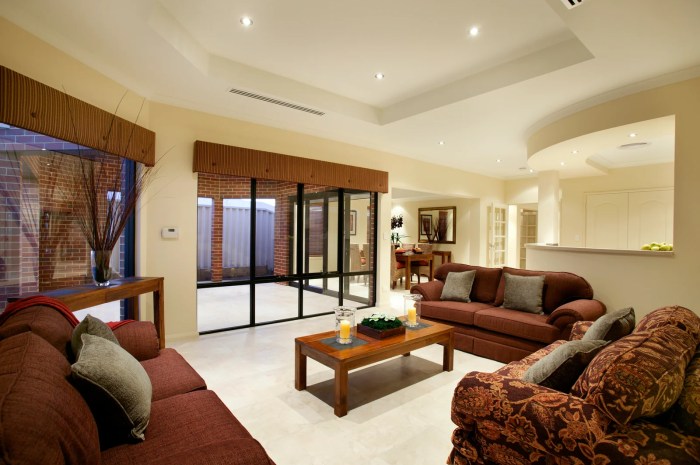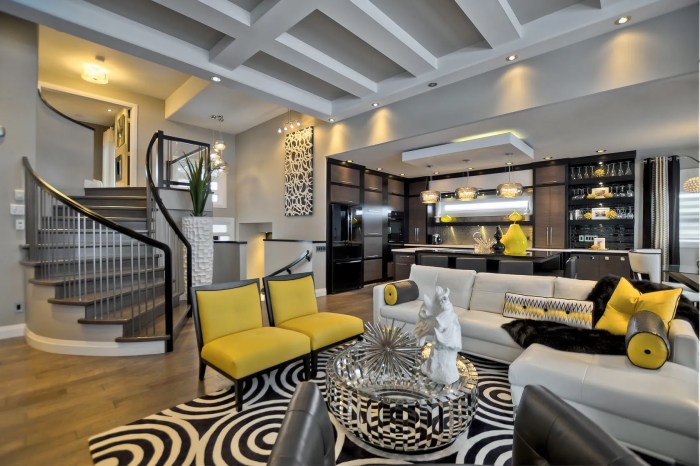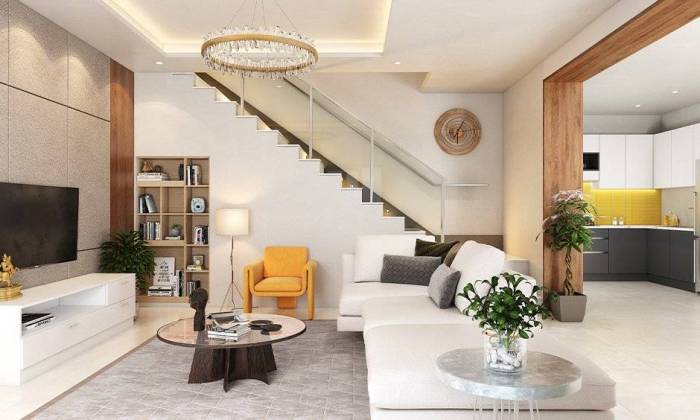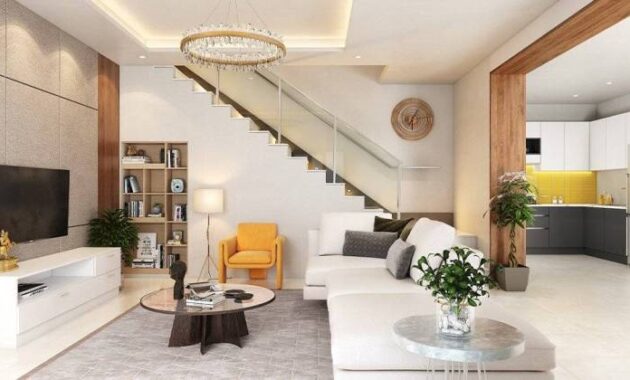Complete interior design of a house goes beyond simply decorating; it’s about creating a space that truly reflects the homeowner’s personality and lifestyle. This comprehensive guide delves into the key aspects of transforming a house into a home, from understanding the homeowner’s vision to selecting furniture and incorporating decorative elements.
From conceptualizing the perfect layout to selecting the ideal color palette and materials, we explore the intricacies of crafting a cohesive and aesthetically pleasing living environment. We also delve into the importance of lighting, window treatments, and outdoor living spaces, emphasizing how these elements contribute to a harmonious and functional home.
Understanding the Homeowner’s Vision

The homeowner’s vision is paramount to creating a truly personalized and functional space. It’s essential to delve into their lifestyle, aspirations, and preferences to craft an interior design that resonates with their individual needs and aesthetic sensibilities.
Lifestyle, Hobbies, and Interests
Understanding the homeowner’s daily routines, leisure activities, and passions provides valuable insights into their functional and stylistic requirements. For instance, a homeowner who enjoys hosting elaborate dinner parties might require a spacious dining room with ample seating and elegant décor.
Conversely, a homeowner who prioritizes quiet evenings at home might prefer a cozy living room with comfortable seating and soft lighting.
Aesthetic Preferences
Aesthetic preferences are a crucial aspect of interior design, shaping the overall ambiance and character of a space. It’s important to determine the homeowner’s preferred style, whether it’s modern, traditional, minimalist, eclectic, or a blend of various influences. For example, a homeowner who gravitates towards modern design might favor clean lines, minimalist furnishings, and a neutral color palette.
In contrast, a homeowner who prefers a traditional aesthetic might opt for ornate details, rich fabrics, and classic furniture pieces.
Functional Requirements
Functional requirements encompass the practical aspects of a home, ensuring that it meets the homeowner’s daily needs and lifestyle. This involves identifying specific spaces and features that are essential to their daily routine. For example, a homeowner who works from home might require a dedicated home office with ample storage and natural light.
Similarly, a family with young children might need a playroom that’s both safe and stimulating.
Space Planning and Layout
Space planning and layout are crucial aspects of interior design that determine the functionality and flow of a home. A well-designed layout optimizes space utilization, creates distinct areas for different activities, and ensures smooth movement throughout the house.
Creating a Functional Floor Plan
A floor plan is a visual representation of the house’s layout, showing the arrangement of rooms, walls, doors, and windows. It serves as a blueprint for the design process, allowing the designer to visualize the space and make informed decisions about furniture placement, traffic flow, and overall functionality.
Optimizing Space Utilization
Effective space planning involves maximizing the usable area while minimizing wasted space. This can be achieved through:
- Open-Concept Design:Combining living, dining, and kitchen areas into one large space creates a sense of openness and allows for flexibility in furniture arrangement. This approach is particularly effective in smaller homes where maximizing usable space is essential.
- Built-in Storage:Utilizing built-in cabinets, shelves, and closets provides ample storage space while minimizing visual clutter and maximizing floor space.
- Multifunctional Furniture:Selecting furniture with multiple purposes, such as a sofa bed or a coffee table with built-in storage, helps to maximize space efficiency.
Defining Functional Areas
Each room in a house should have a clear purpose and be designed accordingly. The layout should accommodate the specific needs and activities that will take place in each area. For example, the living room should be designed for relaxation and entertainment, while the kitchen should be optimized for cooking and meal preparation.
Ensuring Smooth Traffic Flow
Traffic flow refers to the movement of people throughout the house. A well-designed layout ensures that traffic flow is smooth and efficient, minimizing congestion and creating a comfortable living environment.
- Wide Hallways and Doors:Spacious hallways and doorways allow for easy movement, particularly in high-traffic areas like the entryway and kitchen.
- Strategic Furniture Placement:Furniture should be positioned to allow for easy passage and avoid creating bottlenecks.
- Clear Pathways:Maintaining clear pathways throughout the house ensures that movement is unobstructed.
Color Palette and Materials

The color palette and materials chosen for a home’s interior design play a crucial role in creating a cohesive and aesthetically pleasing environment. These elements should complement the homeowner’s style and vision while also considering the practical aspects of durability and functionality.The color palette is a fundamental aspect of interior design, setting the tone and mood of the space.
It’s essential to select colors that work harmoniously together, creating a sense of balance and visual appeal.
Color Palette Selection
The color palette should be chosen in alignment with the homeowner’s preferences and the overall design style. For example, a modern home might feature a neutral palette with pops of bold color, while a traditional home might incorporate warm earth tones and rich jewel tones.
Designing a complete interior for a house can be a challenging yet rewarding endeavor. It involves considering every aspect, from furniture and lighting to color schemes and textures. For those with smaller homes, a focus on maximizing space and functionality is essential.
A great example of this is a 2 bedroom house interior design where clever layout and storage solutions can transform a compact space into a comfortable and stylish living environment. Ultimately, whether you’re working with a large or small space, the goal is to create a cohesive and inviting atmosphere that reflects your personal style.
Here are some tips for selecting a cohesive color palette:
- Start with a neutral base: This could be a light gray, beige, or white, which will provide a backdrop for other colors.
- Introduce accent colors: These are the colors that will add pops of personality and visual interest. Consider using 2-3 accent colors, keeping in mind their complementary nature.
- Create a mood board: A mood board is a great way to visualize how different colors will work together. Gather inspiration from magazines, websites, and even nature.
- Consider the impact of natural light: The amount of natural light in a room will affect how colors appear. For example, a room with a lot of natural light can handle bolder colors, while a room with less natural light might benefit from lighter, brighter shades.
Material Selection
Material selection is equally important, impacting the overall look, feel, and functionality of the space. The chosen materials should be durable, easy to maintain, and aesthetically pleasing.
- Flooring: Flooring materials should be chosen based on their durability, ease of maintenance, and aesthetic appeal. Popular options include hardwood, tile, laminate, and carpet. Hardwood floors are known for their durability and classic look, while tile is a good choice for high-traffic areas like kitchens and bathrooms.
Laminate flooring offers a budget-friendly alternative to hardwood, and carpet provides warmth and comfort.
- Walls: Wall materials should be chosen based on their durability, ease of cleaning, and aesthetic appeal. Popular options include paint, wallpaper, and paneling. Paint is a versatile and affordable option, allowing for a wide range of colors and finishes. Wallpaper can add texture and pattern to walls, while paneling provides a more rustic or traditional look.
- Countertops: Countertops should be durable, easy to clean, and resistant to heat and scratches. Popular options include granite, quartz, laminate, and butcher block. Granite and quartz are known for their durability and elegance, while laminate is a more affordable option.
Butcher block is a natural material that adds warmth and character to kitchens.
- Cabinetry: Cabinetry should be durable, functional, and aesthetically pleasing. Popular options include wood, laminate, and painted cabinets. Wood cabinets are a classic choice, offering a timeless look and durability. Laminate cabinets are a more affordable option, and painted cabinets offer a wide range of colors and finishes.
Natural Light and Material Interaction
Natural light plays a crucial role in how colors and materials appear in a space.
The way natural light interacts with a room’s color palette and materials can dramatically affect the overall ambiance.
For example, a room with a lot of natural light might appear brighter and more inviting, while a room with less natural light might feel more intimate and cozy. The way light reflects off different materials can also affect the overall look and feel of a space.
For example, glossy surfaces reflect light more than matte surfaces, creating a brighter and more energetic feel.
Furniture Selection and Placement

Selecting and arranging furniture is crucial for creating a functional and aesthetically pleasing interior. The furniture you choose should not only complement the overall design style but also meet the practical needs of the homeowner.
Furniture Selection
When choosing furniture, consider both its functionality and aesthetic appeal. Furniture should serve a purpose, whether it’s providing seating, storage, or display. It should also complement the overall design style of the room.
- Consider the scale and proportion of furniture in relation to the room size.Large furniture can overwhelm a small space, while small furniture can get lost in a large room.
- Choose furniture with a variety of textures and materials.This will add visual interest and depth to the space.
- Think about the color and finish of the furniture.Furniture should complement the overall color palette of the room.
- Don’t forget about lighting.Lighting can be used to highlight furniture and create a warm and inviting atmosphere.
Furniture Placement
The placement of furniture is just as important as its selection. Furniture should be arranged to create comfortable seating areas and define different zones within each room.
- Create a focal point.This could be a fireplace, a large window, or a piece of artwork.
- Arrange furniture to create conversation areas.Seating should be placed facing each other, with coffee tables or side tables within easy reach.
- Define different zones within each room.For example, you could create a separate reading nook or a dining area within a living room.
- Leave enough space for traffic flow.People should be able to move freely around the room without bumping into furniture.
Furniture Arrangement Tips, Complete interior design of a house
There are a few general tips for arranging furniture that can help create a comfortable and inviting space:
- Use a rug to define a seating area.A rug can help to anchor furniture and create a sense of separation between different zones.
- Experiment with different arrangements.Don’t be afraid to move furniture around until you find an arrangement that you like.
- Add accessories to personalize the space.Throw pillows, blankets, and artwork can add warmth and personality to a room.
Lighting Design
Lighting is an integral part of interior design, shaping the ambiance and functionality of each space. It’s about creating a balanced and inviting atmosphere through a thoughtful combination of ambient, task, and accent lighting.
Natural Light Maximization
Natural light is a valuable asset in any home, contributing to a sense of spaciousness and well-being. Maximizing natural light is crucial for creating a welcoming and comfortable environment.
Strategic Window Placement
Properly positioned windows allow sunlight to penetrate deep into the room, illuminating even the corners. For instance, placing windows on opposite walls creates a cross-ventilation effect, enhancing air circulation and bringing in more natural light.
Window Treatments
Window treatments play a vital role in controlling the amount of natural light entering a room. Sheer curtains, for example, allow soft, diffused light while still offering privacy. Blinds and shades offer greater control, allowing you to adjust the amount of light entering the space.
Light Reflecting Surfaces
Light-colored walls and ceilings reflect natural light, making the room appear brighter and more spacious. Using mirrors strategically can also help to bounce light around the room, maximizing its effect.
Ambient Lighting
Ambient lighting provides general illumination for a room, setting the overall mood and atmosphere.
Types of Ambient Lighting Fixtures
Chandeliers
Chandeliers, especially in dining rooms and living rooms, add a touch of elegance and grandeur. They provide a strong source of ambient light and act as a focal point in the space.
Recessed Lighting
Recessed lights are discreetly installed in the ceiling, offering even illumination without taking up valuable space. They are particularly suitable for creating a soft, diffused light throughout the room.
Track Lighting
Track lighting allows for flexibility, enabling you to adjust the direction and focus of the light. This makes it ideal for highlighting specific areas or artwork.
A complete interior design project encompasses every detail, from choosing the right furniture to selecting the perfect paint color. If you’re considering a warm and inviting atmosphere, a brown house interior design scheme might be the perfect choice. By incorporating different shades of brown, you can create a sense of comfort and sophistication that complements any style, ultimately contributing to a cohesive and well-designed home.
Task Lighting
Task lighting provides focused illumination for specific activities, ensuring adequate visibility for tasks like reading, cooking, or working.
Types of Task Lighting Fixtures
Pendant Lights
Pendant lights, often hung over kitchen islands or dining tables, provide focused light while adding a decorative element to the space.
Sconces
Sconces, mounted on walls, are a versatile option for task lighting. They are particularly suitable for illuminating reading nooks or bedside tables.
Under-Cabinet Lighting
Under-cabinet lighting is a practical solution for illuminating kitchen countertops and workspaces, making it easier to prepare food and perform tasks.
Accent Lighting
Accent lighting highlights specific features or objects in a room, adding depth and visual interest.
Types of Accent Lighting Fixtures
Spotlights
Spotlights can be used to highlight artwork, sculptures, or architectural details, creating a dramatic effect.
Uplighting
Uplighting, directed upwards towards the ceiling, can make a room appear taller and more dramatic. It’s particularly effective for highlighting architectural features like columns or beams.
Downlighting
Downlighting, directed downwards, can create a cozy and intimate atmosphere. It’s often used to highlight furniture or decorative elements.
Lighting Control
Controlling lighting allows you to adjust the ambiance of a room to suit different moods and activities.
Dimmers
Dimmers allow you to control the intensity of light, creating different atmospheres. For example, dimming the lights in the evening can create a relaxed and inviting ambiance.
Smart Lighting
Smart lighting systems offer greater control and automation, allowing you to adjust lighting levels and schedules remotely. This can be particularly useful for creating different lighting scenarios for different times of day or activities.
Lighting Considerations
Color Temperature
Color temperature, measured in Kelvin (K), affects the perceived color of light. Warm white (2700-3000K) is often used for creating a cozy and inviting atmosphere, while cool white (4000-4500K) is better suited for task lighting.
Energy Efficiency
Choose energy-efficient lighting options, such as LED bulbs, to reduce energy consumption and save on electricity bills.
Safety
Ensure all lighting fixtures are properly installed and meet safety standards. Use bulbs that are compatible with the fixtures and avoid overloading circuits.
Window Treatments
Window treatments are an essential element in interior design, as they not only provide privacy and light control but also enhance the overall aesthetic of a space. They can dramatically transform the look and feel of a room, adding warmth, elegance, or a touch of modern flair.
Types of Window Treatments
Window treatments come in a wide variety of styles, materials, and functionalities, offering a range of options to suit different needs and preferences.
Complete interior design encompasses every detail, from furniture selection to wall treatments. A popular style, often incorporated into these designs, is arts and crafts house interior design , known for its emphasis on natural materials and handcrafted elements. This style brings warmth and authenticity to a home, adding a unique touch to the overall design.
- Curtains: Curtains are a classic and versatile window treatment that can add softness, elegance, and a sense of drama to a room. They come in various fabrics, colors, and patterns, allowing for endless customization possibilities.
- Blinds: Blinds offer a more practical and functional approach to window treatments. They are available in various materials, including wood, metal, and plastic, and can be adjusted to control light and privacy levels.
- Shades: Shades are a popular choice for their simplicity and clean lines. They are often made of fabric or bamboo and offer a range of light-filtering options, from sheer to blackout.
Choosing the Right Window Treatments
The choice of window treatments depends on several factors, including the style of the room, the desired level of privacy, and the amount of natural light required.
- Consider the overall design scheme: Window treatments should complement the existing décor and color palette of the room.
- Think about light control: If you need to block out sunlight, consider blackout shades or heavy curtains. For a softer effect, sheer curtains or blinds can be used.
- Evaluate privacy needs: If you need maximum privacy, consider curtains or blinds that can be completely closed. For a more open feel, sheer curtains or blinds can be used.
Fabric and Color Selection
Fabric and color play a crucial role in determining the overall look and feel of window treatments.
- Fabric: Choose fabrics that complement the style and color scheme of the room. Consider the weight, texture, and drape of the fabric.
- Color: The color of the window treatments should be chosen carefully to enhance the existing color palette of the room. Consider using a contrasting color for a bold statement or a complementary color for a more subtle look.
Decorative Elements
Decorative elements are the finishing touches that add personality and visual interest to a space. They transform a house into a home, reflecting the homeowner’s style and creating a welcoming atmosphere. These elements can be anything from artwork and sculptures to plants and textiles.
Artwork and Sculptures
Artwork and sculptures serve as focal points and add visual interest to the rooms. They can be used to create a sense of balance and harmony, or to add a touch of whimsy and personality.
- Choose pieces that reflect the homeowner’s style.If the homeowner is drawn to abstract art, incorporate pieces with bold colors and geometric shapes. If they prefer traditional art, consider landscapes or portraits.
- Consider the size and scale of the artwork.A large painting can overwhelm a small room, while a small sculpture may get lost in a large space.
- Think about the lighting.Artwork should be illuminated to showcase its details and enhance its visual impact.
Plants
Plants bring life and vibrancy to a space. They can be used to add color, texture, and a sense of nature.
- Choose plants that are appropriate for the lighting conditions.Some plants thrive in bright sunlight, while others prefer shade.
- Consider the size and shape of the plants.Large plants can make a statement, while small plants can add pops of color and texture.
- Arrange plants thoughtfully.Group plants together to create a visual impact or place them strategically to add interest to a specific area.
Textiles
Textiles add warmth, texture, and personality to a space. They can be used to create a cohesive look or to add pops of color and pattern.
- Choose textiles that complement the color palette and style of the room.For example, if the room is decorated in a minimalist style, choose simple, solid-colored textiles.
- Consider the texture of the textiles.Soft, plush fabrics can create a cozy atmosphere, while rougher textures can add a touch of rusticity.
- Use textiles to add visual interest.A throw blanket, a decorative pillow, or a patterned rug can add a touch of personality to a room.
Ultimate Conclusion: Complete Interior Design Of A House
Ultimately, complete interior design of a house is a collaborative journey between the homeowner and the designer. By carefully considering the homeowner’s needs and preferences, and by employing a systematic approach, we can create a truly personalized and beautiful space that is both functional and inspiring.
Popular Questions
What are the different interior design styles?
There are many interior design styles, including modern, contemporary, traditional, minimalist, farmhouse, industrial, and eclectic, each with its unique characteristics and aesthetic appeal.
How do I choose the right interior designer?
Look for an interior designer with experience in your desired style, a good portfolio, and positive client testimonials. It’s also important to feel comfortable communicating with them and to ensure their design philosophy aligns with your vision.
What is the typical cost of complete interior design?
The cost of interior design varies depending on the size of the project, the complexity of the design, and the materials used. It’s best to get quotes from multiple designers to compare pricing and services.

